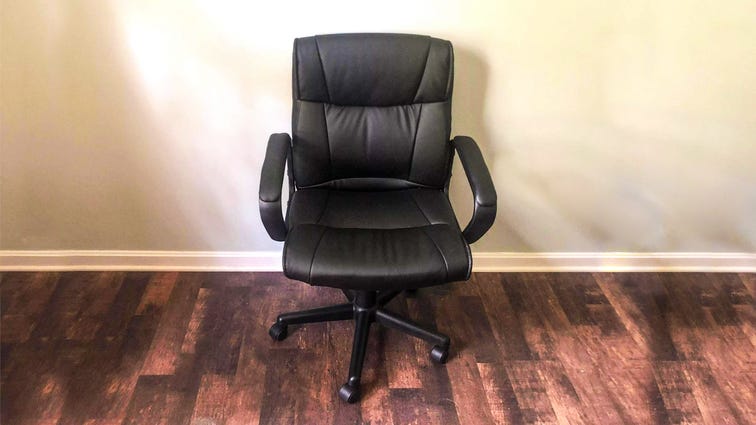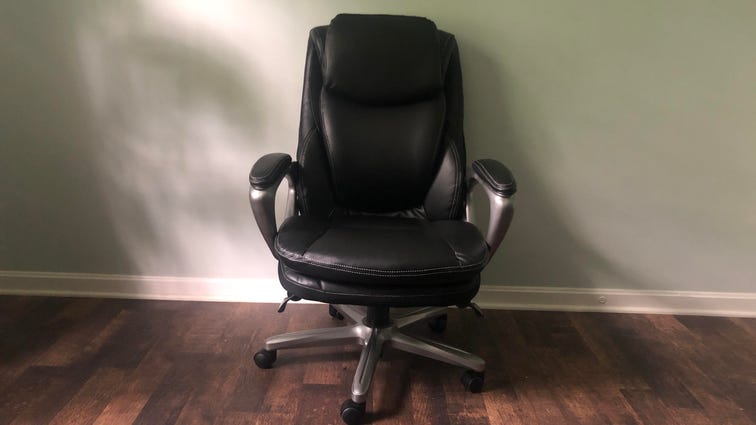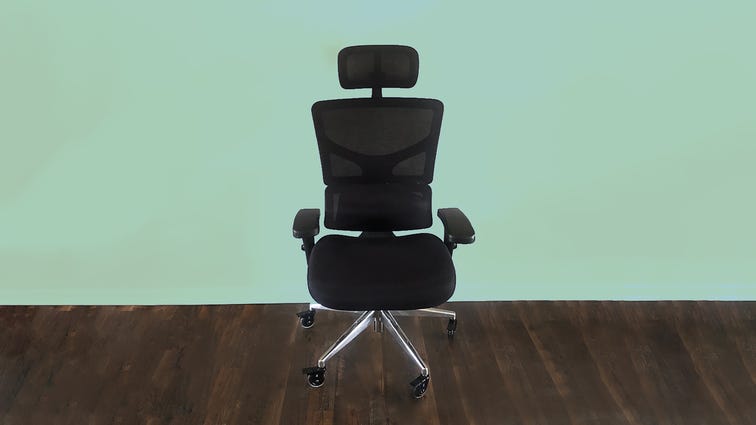Despite being someone who sits the majority of the workday, I’ve never given office chairs much thought. Before COVID-19, I spent most of my work hours at the CNET Smart Home, an actual house where we test security cameras, smart speakers and other gadgets. I filed stories from upright dining room chairs, cushioned sofas and butt-numbing patio furniture.
I initially stuck with my Smart Home method when I started working from my own home. Some days, I wrote from a sofa; other days, I sat in a rocking chair on the front porch. No two days were the same, and I slowly realized it was terrible for my back and my posture.
It was time to make a change and get a good office chair. So I tested out 14 office chairs, ranging in price from $32 to $1,545, knowing we’d be buying a couple of the favorites for our own home when I finished. I also spoke with an ergonomics expert for general tips on how to improve work setups, whether that’s at home or in a more traditional office setting. Let’s look at the best office chairs of the bunch.
Note: Product pricing tends to vary on third-party sites, so the prices I quote as of writing this may fluctuate over time. I’ll do my best to update the list often to reflect the most accurate prices at the time of publishing.
The best office chairs

 \n ","topic":"","ttag":"","variant":"","viewguid":"","event":"listicle|image|1","correlationId":"","_destCat":"https:\/\/www.amazon.com\/dp\/B00IFHPVEU","productName":"Best overall and best under $100: AmazonBasics leather-padded swivel office chair","formatType":"IMAGE","location":"LIST","position":1,"sku":"","dwLinkTag":"article-body|listicle|image","selector":"#article-body #listicle-3208a6ef-a68e-4a92-b68f-505c69d3928b .itemImage"}}” rel=”noopener nofollow” target=”_blank”>
\n ","topic":"","ttag":"","variant":"","viewguid":"","event":"listicle|image|1","correlationId":"","_destCat":"https:\/\/www.amazon.com\/dp\/B00IFHPVEU","productName":"Best overall and best under $100: AmazonBasics leather-padded swivel office chair","formatType":"IMAGE","location":"LIST","position":1,"sku":"","dwLinkTag":"article-body|listicle|image","selector":"#article-body #listicle-3208a6ef-a68e-4a92-b68f-505c69d3928b .itemImage"}}” rel=”noopener nofollow” target=”_blank”>


Megan Wollerton/CNET
I liked this AmazonBasics chair right away. This swivel chair was easy to assemble, the leather design looks nice, and the adjustable seat and back are both cushioned and comfortable. At $79, this AmazonBasics chair isn’t exactly cheap, but it’s a great option that’s relatively affordable without sacrificing much, with one exception: lumbar support.
If lumbar support is an ergonomic office chair feature that’s a must for you, consider one of my other favorites.
Overall, though, this is a comfortable, reasonably priced ergonomic chair that’s easy to put together and easy on the eyes.
Fast facts:
- Finish: Black leather
- Adjustable height/Tilt
- Weight capacity: 275 pounds

 \n ","topic":"","ttag":"","variant":"","viewguid":"","event":"listicle|image|2","correlationId":"","_destCat":"https:\/\/www.amazon.com\/dp\/B012Y0XN9S","productName":"Best midrange and most comfortable: Serta Smart Layers Arlington Air executive chair","formatType":"IMAGE","location":"LIST","position":2,"sku":"","dwLinkTag":"article-body|listicle|image","selector":"#article-body #listicle-6ef7a17c-4919-49e5-b892-0f430b48d198 .itemImage"}}” rel=”noopener nofollow” target=”_blank”>
\n ","topic":"","ttag":"","variant":"","viewguid":"","event":"listicle|image|2","correlationId":"","_destCat":"https:\/\/www.amazon.com\/dp\/B012Y0XN9S","productName":"Best midrange and most comfortable: Serta Smart Layers Arlington Air executive chair","formatType":"IMAGE","location":"LIST","position":2,"sku":"","dwLinkTag":"article-body|listicle|image","selector":"#article-body #listicle-6ef7a17c-4919-49e5-b892-0f430b48d198 .itemImage"}}” rel=”noopener nofollow” target=”_blank”>


Megan Wollerton/CNET
It isn’t the most sleek-looking chair around, but what the Serta Arlington lacks in style it more than makes up for in comfort and customizability. Serta is best known as a mattress-maker, and that tracks with the supremely comfortable Arlington chair. This ergonomic chair is by far the most cushioned model I tried out, with layers of soft cushioning on the headrest, backrest, seat and armrests.
It also provides decent support, thanks to an adjustable lumbar lever under the seat.
It currently costs $254, down from the $300 list price. If you’re looking for a comfortable office chair with customizable lumbar support at a midrange price, this is a great option.
Fast facts:
- Finish: Black leather
- Weight limit: 275 pounds

 \n ","topic":"","ttag":"","variant":"","viewguid":"","event":"listicle|image|3","correlationId":"","_destCat":"https:\/\/www.xchair.com\/x3build.html","productName":"Best splurge: X-Chair X3 ATR management chair with Elemax","formatType":"IMAGE","location":"LIST","position":3,"sku":"","dwLinkTag":"article-body|listicle|image","selector":"#article-body #listicle-d79c20fd-e058-4bdb-92bb-91f908cd9e77 .itemImage"}}” rel=”noopener nofollow” target=”_blank”>
\n ","topic":"","ttag":"","variant":"","viewguid":"","event":"listicle|image|3","correlationId":"","_destCat":"https:\/\/www.xchair.com\/x3build.html","productName":"Best splurge: X-Chair X3 ATR management chair with Elemax","formatType":"IMAGE","location":"LIST","position":3,"sku":"","dwLinkTag":"article-body|listicle|image","selector":"#article-body #listicle-d79c20fd-e058-4bdb-92bb-91f908cd9e77 .itemImage"}}” rel=”noopener nofollow” target=”_blank”>


Megan Wollerton/CNET
OK, I know. This office chair is very expensive, but it also has a lot going for it: tons of ergonomic design and feature options at checkout, lots of adjustabilities and lumbar support. Three of the optional add-ons really set this one apart for me — clear locking “X-wheels,” Elemax and a memory foam seat.
I can only describe X-wheels as the most high-end roller skate or rollerblade wheels. The chair literally glides when you move it around and the locking mechanisms make it easy to keep in one place, too. Elemax is at a whole other level for an ergonomic office chair. This option provides massage, heat and cool functions that blend in pretty seamlessly with the chair. If you have to sit all day for work and experience pain (or just want to pamper yourself a bit), this function really makes a difference.
The X3 chair also has a weight capacity of 300 pounds (with the standard seat width option) and 340 pounds (with the extended seat width option), the best range of the 14 chairs I tested.
The one issue is its price, which is why it didn’t win for best chair overall — the price just isn’t reasonable for most people, us included. I will be sad to see this one go.
Fast facts:
- Finish: Multiple color options, mesh and memory foam
- Weight capacity: 300 pounds (standard seat width); 340 pounds (extended seat width)
An awesome chair alone isn’t enough
Ergonomics is the “science of work,” explains Gary Allread, the program director for the ergonomics division at Ohio State University’s Spine Research Institute. That definition doesn’t just apply to our jobs, though; ergonomic principles can be used for pretty much any activity (that means an ergonomic office chair isn’t going to immediately fix your lower back pain). Allread and his team offer consultation services for a variety of workplaces, including manufacturing plants. They even occasionally provide input on product design to help companies better understand how to create products “to make sure they can interact with people as well as possible,” Allread says.
A less-than-ideal work setup might cause pain in your back, arms, hands or wrists. You might also find yourself fidgeting, making more mistakes or taking more breaks, all because you’re uncomfortable, says Allread. Long-term, you might end up with tendonitis or carpal tunnel syndrome.
Allread makes two main suggestions we all can try to improve how we work:
- Sit with your back against your chair. (“You want the chair to do the work and not your back,” he explains.)
- Support your feet. Either plant your feet on the floor or, if they don’t reach, use a box or other footrest to support your feet.
If your chair lacks lumbar support, Allread adds, you can roll up a towel, secure it with tape or rubber bands and place it at your lower back as a lumbar cushion to “keep the back in its natural curve.” Allread also notes that companies are beginning to introduce different chair sizes, supporting a wider range of body sizes, which is an important consideration if you’re shopping for a new ergonomic office chair and looking for the best seat height and seat depth.
“One mistake people make is they say, ‘Well if I get a great chair, then I’m not going to be sore anymore,’ and that’s not really looking at the big picture of what it takes to keep people comfortable and productive at their jobs,” explains Allread. There are a lot of factors, and a new chair is just one of many things that can make your work environment more comfortable.
So, let’s keep that all in mind as we weigh our options for the best office chair.
How we tested office chairs
Here’s a complete list of the office chairs I tested:
How did I pick my favorites? First, I assembled each chair and noted any issues with the process, with the exception of the Herman Miller Aeron and Lino chairs and the Steelcase Gesture Chair, since they arrived fully assembled (bonus points for that). Then, I spent one workday, or about eight hours, sitting in each chair, noting the level of comfort, adjustability (such as adjustable height, adjustable backrest or adjustable arm features) and any issues I had. I also asked my husband to try out each chair. For reference, I’m 5-foot-7, he’s 6-foot-2, and we’re both an average weight.
What might work for me or for him may not work for you, but I kept in mind all of the tips Gary Allread from the Spine Research Institute had mentioned as I sat and asked Kevin to do the same:
- Was the chair designed so I could rest comfortably against the back of the chair?
- Did my feet touch the floor with my back against the back of the chair?
- Did I find myself fidgeting or standing up a lot?
- Did I experience any pain or discomfort while using a particular chair?
I had to immediately cut the Hodedah Armless Task Chair from the running, after noticing a label inside the box that read “NOT FOR ADULT USE.” Apparently this chair, which regularly appears on lists of adult office chairs, has a 100-pound weight limit. I wasn’t alone, either — a number of customers have written reviews online expressing frustration that this chair (which at first appears to be marketed to adults, on Home Depot’s website if not Amazon) broke while they were using it. If you’re an adult under 100 pounds, this chair could potentially work for you, but its limited features, including no armrest, completely ruled it out for me regardless.
So we were down to 13 chairs. Despite looking pretty nice and cushioned, the OFM Essentials Collection Executive Office Chair was a little stiff and uncomfortable. It also lacks lumbar support. The HON Exposure Mesh Task Computer Chair also lacks lumbar support, and it leans back too far for both of us, making it uncomfortable to sit with our backs against the backrest as Allread suggests. The BestOffice Mid-Back Ergonomic Desk Chair leans back too far as well, though it did have a bit more lumbar support than the HON Exposure chair.
The Humanscale Freedom Chair arrived mostly assembled; I just had to connect the top half and the wheelbase. Despite the simplicity of putting this Humanscale chair together, I struggled to adjust the chair without consulting the instructions. Even after figuring it out, my husband and I both found the backrest and headrest oddly proportioned and extremely uncomfortable on our backs and necks. The Steelcase Gesture Chair is highly adjustable and feels sturdy. But even with the Steelcase chair’s many customizable controls, including a seat depth adjuster set to maximum depth, the seat was much too short and angled downward, making me feel like I could slide out of the chair.
The Gaiam Classic Balance Ball Chair was a bit of an experiment. It’s an exercise balance ball with a chair frame. While I definitely got a core workout while using it, it isn’t a sustainable option as an all-day office chair.
Both Herman Miller chairs were very nice, but not enough to justify their high prices. The Hbada Office Task Desk Chair was a little small for us both and didn’t provide full back support. The Uplift J3 Ergonomic Chair was a little too stiff and uncomfortable.
The other three chairs I included in the best office chair list above kept us comfortable all day and offered degrees of adjustability that set them apart from the pack. For more advice on the best items to buy, check out other CNET best lists.
Office chair FAQs
How do I clean my office chair?
How you clean your office chair will vary somewhat depending on the materials. The chair’s user manual should detail cleaning and general maintenance tips. If you tossed out the paper version of the manual, check online. Many retailers provide digital versions or even downloadable PDFs of their product manuals.
That said, most chairs should be fine with a damp cloth and mild soap or detergent. Test out a small area first and stay away from strong chemical cleaners.
How do I make an office chair more comfortable?
Many office chairs are adjustable. You can change the chair height and move the arms, and some office chairs even have adjustable lumbar support. So before tossing out your current chair, make sure you’re sitting in an optimal posture for your comfort by trying out different ergonomic positions.
I cover ergonomics above. Allread, the expert I spoke with, had two main suggestions:
- You want your back to touch the back of the chair.
- You want your feet to touch the floor (or you should use a box or footrest to prop up your feet).
Allread also suggests rolling up a towel to use for lower back support if your chair doesn’t have lumbar support.
How do I fix a squeaky office chair?
If you’re dealing with a squeaky office chair, you first need to identify the source. Double-check that all of the screws are tight and that the chair is clean and oiled. You might also need to replace a spring. Certain retailers sell replacement parts, if a loose/old spring ends up being the culprit.

